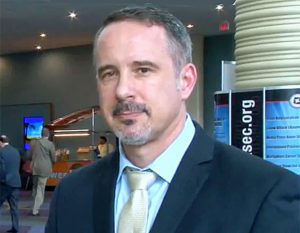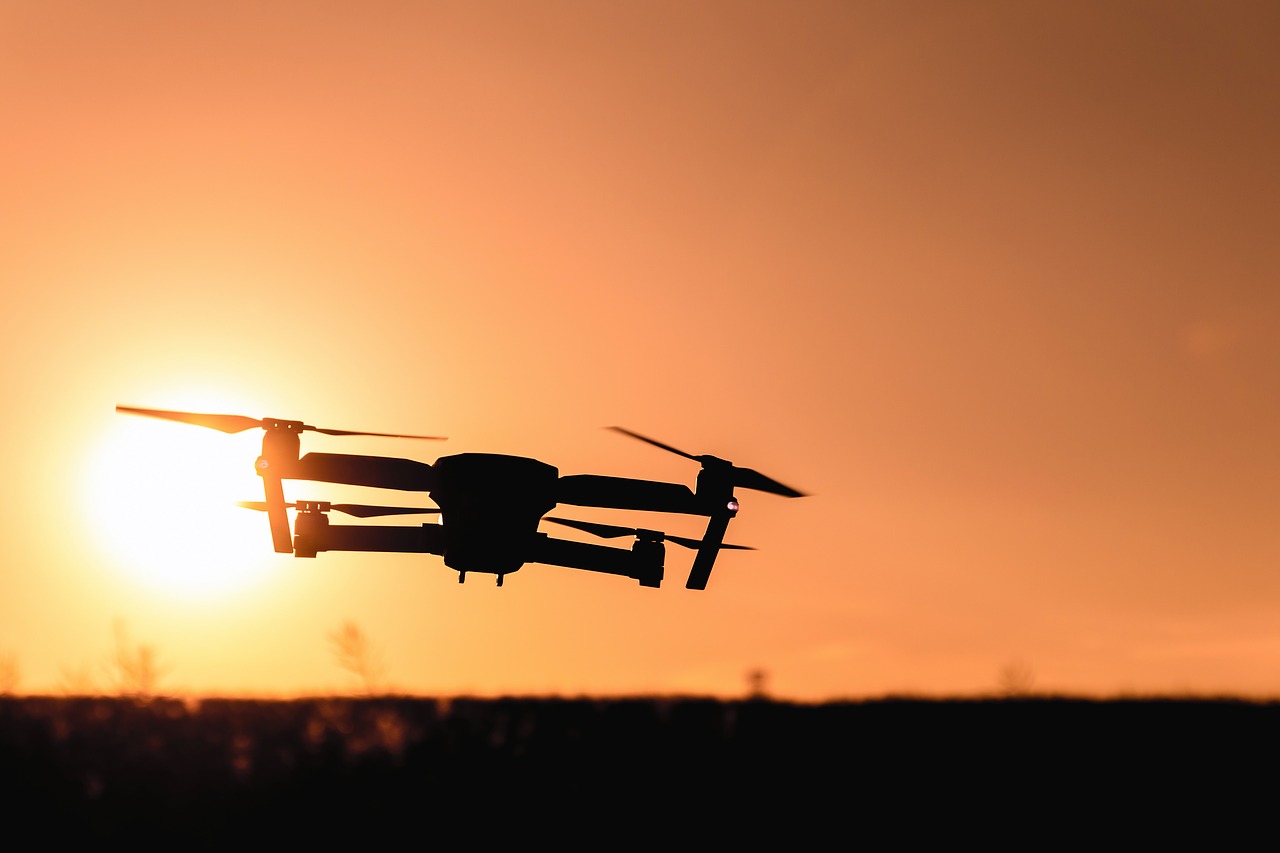Articles talking about why a given year is the “year of the drone” go all the way back to 2010, although they certainly didn’t start that year. Similar declarations have been made more recently about 2015 and 2016, and the claims in those years were specifically related to the commercial applications of UAV technology. The hype associated with commercial drone technology has been nothing if not bombastic, and these headlines helped fuel such enthusiasm. For all these reasons, proclamations about 2017 or even 2018 being the “year of the drone” should be taken with a grain of salt.
However, during his
Commercial UAV Expo 2017 keynote, Mike Blades, North American Research Director for Aerospace, Defense & Security at Frost & Sullivan, explained why 2017 had a better claim to this title than any other year. What really made 2017 different for commercial operators though? Which of the factors that made 2017 so significant will continue to impact us in 2018 and beyond?

Mike Blades
To find out, we caught up with Mike to ask him these questions and also to find out if 2018 would eventually be able to claim this “year of the drone” title. Some of these details pick up on the in-depth info he laid out in his
recent industry report, but you also can hear much more from Mike by
following him on Twitter.
Jeremiah Karpowicz: During your keynote at the Commercial UAV Expo, you mentioned that you thought 2017 was the “year of the drone”, and talked about six clear areas of growth for 2018. What do you think made 2017 specifically significant in a way previous years were not? Mike Blades: I think 2017 was pivotal in the United States more than anywhere else, because it was the year we really saw the advantages associated with Part 107 come online. Part 107 became active at the end of 2016, but 2017 was when the advantages really came to fruition. That's when you saw adoption in areas like construction, aggregates, surveillance, surveying, etc. For that reason, I think it was the "year of the drone" moreso than any other year that tried to claim the title.
Something that didn't start in 2017 but culminated last year was a transition of the drone ecosystem from being stovepipe to there being lots of partnerships. There was a concerted effort to move toward a full stack, complete drone solution that is useful for a business or for someone’s customer. We saw a meeting of the minds across the space in terms of some pretty big partnerships, as companies got together to come up with a better understanding of what their end game needed to be, which is a main reason it was such a significant year. Ultimately, that end game is about a value added service or value added information to make better business decisions, quicker business decisions, and decisions that don't cost as much.
But creating and discovering that added value isn’t just about hardware or software, is it? Not when we see things like American Rail Engineers (ARE) acquiring companies like Media Wing. Exactly, and it’s something I’ve seen come on in a big way since the Expo.
We’re seeing construction companies, railroads companies like ARE and even inspection companies buying up companies that offer drone services. What they're trying to do is integrate some drone expertise into what they already do. That’s a much different value proposition than someone who just a couple years ago could get their Section 333 Exemption and then tell farmers that they could help them.
Just because you know how to fly a drone doesn't make you an agronomist. Just because you can fly a drone over cell towers doesn’t mean that you're an expert in inspecting them. What happened was that there was no useful information provided to the people who were paying for those services. The people with their Section 333s, could get the data, but they couldn't reduce it to something that was usable for the client. That’s changed as organizations are looking to acquire this kind of expertise in a much more refined and defined manner.
Other experts have outlined a similar perspective, so does all of this change the game for service providers? To me, there's not going to be a whole lot of room for small businesses, unless they're doing things like aerial photography video, or maybe some real estate video. The real enterprise uses, for oil and gas, construction, aggregates, etc. are all going to be done by large companies. I think the small guys are going to be left out, or they're going to need to work for those large companies, as in the case of an acquisition.
That’s really the transition that separated 2017. Instead of taking a bottom up approach, companies are now going from the top down. A larger company will already have a SME that handles a lot of the things service providers are offering, so how the organization brings drones into the mix to make that SME more efficient is their focus. Companies like John Deere and Caterpillar are all integrating drones into what they already do, which makes it that much easier for a SME to adopt the technology effectively.
In that case, has the question of “outsource or build” when it comes to drones been finalized? It’s always going to depend, but I am seeing more companies want to bring their drone services in house instead of having a 3rd party doing it. I have a feeling that that might be based on size though. I don't think a lot of small companies are going to do that, but the larger companies might want to have a handle on everything and not worry about 3rd party contracts and liabilities if they can bring it in house.
That said, the adoption rate for using drones is restrained a little bit, just because there are large companies that are resistant to change, and they don't want to make that leap until they're 100% convinced and 100% assured that they're getting an ROI. And there is a lot of work that needs to be done on the topic of ROI in some areas. Drones are going to save a lot of money and time in certain applications, but sometimes the best way of doing something might already be happening. That’s a different calculation based on your size, industry, etc.
Does that mean the greatest opportunities in the market are going to be specific to an organization or even an entire industry? It all depends on how you look at the drone market.
The way I look at the commercial drone market is that I see it as a market that is bifurcating very quickly. Right now, I have drones segmented out into consumer, prosumer (under 5K) and professional (5-20K) categories. At that professional level, you have your higher endurance, higher payload drones like ones that carry heavy cameras.
That’s actually part of where we’ll see some opportunities in this market in terms of drone repair and maintenance. A certain percentage of the relatively inexpensive drones are just going to be replaced. There will be a need for refurbishing, but there's already a market for that. The real opportunity is going to be in those enterprise drones, especially as they become more autonomous.
As this happens, they're going to have to have more redundant systems, more protection from the weather, etc. All of it will drive and increase the need for repair and maintenance, and probably a higher cost because those things aren't going to be 4-5K, they'll be tens of thousands of dollars. That's where the drone repair and maintenance growth opportunity is going to be, because that’s what’s going to be required to meet the higher standards related to capabilities like BVLOS and flying over people.
So you think we’ll see that many more companies roll out “professional drones” or be focused on technology that is designed to do something industry specific? Companies understand that they can't compete at the lower end quad rotor market. That market is done. It's been won by DJI and they'll continue to win it. Anybody that comes into that market will get priced out by DJI.
The competition will happen in these niche applications with transitional drones or even hybrid drones that use a gas engine to drive their electric motors. They’re going to compete with each other for the different applications that the small quads just can't do. Really, they’re positioning themselves for things like BVLOS and flying over people, and it’s why they’re focused on things like airworthiness. Those kinds of capabilities aren’t going to be allowed if that airworthiness can’t be defined and proven.
All of which will continue to redefine the expectations organizations and even operators have when it comes to this technology, correct?Oh yeah. It’s why that market for things like maintenance and repair is going to develop so rapidly. We’ll see markets being created as a result of these new uses and expectations. There will be a demand for automated drones/drone boxes that stay on site 24/7 like for security and/or multi-mission capabilities for industrial complexes and plants.
I can see a future where there's a group of wind generators, and every month or so someone will wheel out a few "drones in a box”. They’ll be out there for a few days while they do their inspections automatically. Then someone will go back and pull the boxes back. There's no pilot or anything, because it's all automated. You'll have AI algorithms to figure out what needs to be serviced and what doesn't need to be serviced. It's all going to be automated, and at the end you're going to have something that says, “fix this and this and this”, and then you're done.
Some companies are already focused on a future with especially airworthy drones that can do numerous functions with minimal human integration. These are drones that can be controlled by a remote computer, can perform self-assessments, and will be able to fulfill the incredibly specific requirements associated with something like a wind generation inspection.
I suppose that speaks to the importance of something you discussed during the Drone Forecast 2018 episode of the sUAS podcast when you were talking about someone who has their Part 107 trying to suddenly become an expert in multiple industries, doesn’t it? If you look at some of the most successful drone services providers, they stay in one lane. The reason for that is because they have subject matter expertise in that area. They know what an inspection entails, and they figured out how to make a drone help them with it. They're not going off to do precision agriculture.
That focus on a specific area extends to manufacturers as well though. You're going to see platforms that are niche, and sensors that are niche. Look at what Slantrange does. All of their sensors are focused on precision ag. They’re not doing sensors for aggregates.
That kind of niche focus doesn’t have to be industry specific though. Look at the Elios by Flyability. That's something no one else is doing, and it’s been a great tool for interior inspections and inventory management. Velodyne
announced they were cutting the price of the puck in half. Those are just a few examples of the innovation that’s going to drive the space in 2018.
What are you most looking forward to seeing this year? Anything that will allow 2018 to supplant 2017 as the “year of the drone”…even if it’s a title that eventually rolls over to 2019?This industry is about how the technology is driving new approaches and innovation, and there’s a lot of opportunity on the software side. Anyone focused on developing the best software that will be platform agnostic will create value that is going to resonate for a long time.
We’ll see a continued focus on data this year, and importance of the data/information is absolutely critical. It will remain the most important portion of the equation related to what the drones are doing. It's a means to an end, but the end is better, faster, more precise information. And that better, faster, more precise info has to come at a lower cost and enable you to make decisions quicker. Otherwise it's not doing anything that isn't already being done.
At the end of the day, this is not a drone market but an information market. And furthermore, how does that data integrate with and drive big data and/or the IoT? Opportunities lie in not only gathering inspections grade data, but processing it into useful information for real time, or near real time, decision making AND figuring out how to integrate data/information acquired by drones into big data and the trends, patterns, and associations analyzing big data can produce.
This year and next, I think you're going to see a lot of companies bringing the services inside, and then there's going to be a few large services providers that are going to provide people with a lot of their drone needs. A lot of the requirements out there don't require 24-7 drone operations. Once the companies get those drones, they're going to keep them and repair them, so the buying of new drones is going to decrease.
Whether that does, or doesn’t, define what we can definitively call “the year of the drone” remains to be seen, but it’s likely that will continue to be a moving goalpost. Although that kind of moving goalpost is the least of our worries in this space.

















Comments